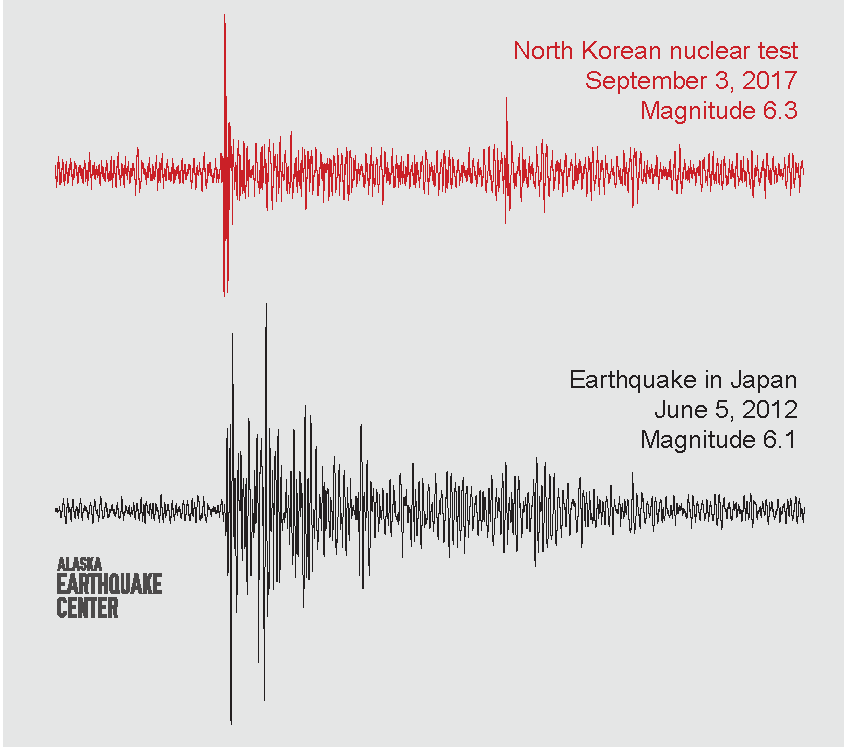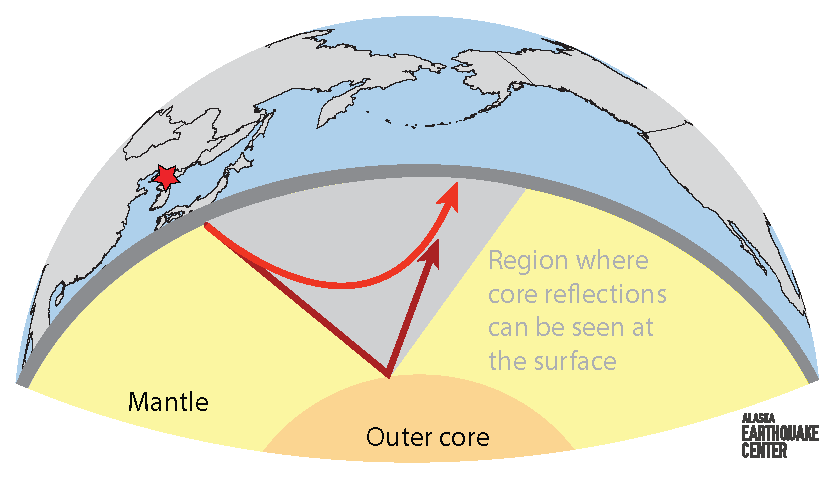

(Sept. 8, 2017) When the North Koreans set off their latest nuclear test last Sunday, we were the first to record the explosion signal as it reached U.S. soil. Alaska is the closest state to North Korea, which might seem counter-intuitive, but when you take into account the curvature of the Earth it is a straight shot heading almost directly west from the Seward Peninsula.
The signal looked spectacular as it rolled across the network. The first signal to arrive, known as the P-wave, registered clearly on seismic stations as far apart as Nome and Juneau. If the signal were from an earthquake, we could sit and wait for the other phases of the seismic energy to arrive. Around 6 minutes after the P-wave rolled in, we would see a bigger signal from the S-wave, followed by host of other ‘arrivals’ - pulses of seismic energy that bounce off various boundary layers of the deep Earth. But because this signal came from an explosion, the seismic data that followed was oddly quiet.
Underground explosions push energy out in all directions, which is very different from how earthquakes radiate energy into the ground. During an earthquake, sections of the crust move suddenly along a fault, causing seismic energy to be forced outwards along the plane of the fault. This is where the S-wave, or shear wave, gets generated. Since an explosion doesn’t involve a fault plane, it doesn’t generate a shear wave. On seismic data, the lack of a shear wave is a tell-tale sign of an explosion.
The lack of an S-wave from the North Korean nuclear test caused a more unusual signal to pop out of the data. Registering as a small but very distinct blip in the data 1-2 minutes after the P-wave arrival, this arrival is one of a handful of signals which has shaped the way we think about the interior of the Earth. This signal is known to seismologists as the PcP-wave, meaning that it is from a P-wave that has travelled towards the center of the Earth but has been reflected back to the surface by the boundary between the mantle and the outer core. These PcP-waves can only be recorded at certain distances away from the source. For a signal coming from North Korea, Alaska is right in the middle of that zone.
Signals such as the PcP-wave are one of the few ways we have for looking into the depths of the Earth. The different layers of the Earth—the mantle, the outer core and the inner core—are all distinct from each other. The inner core is made of solid iron (plus a few other elements thrown in for good measure) and is under tremendous pressure and heat from the rest of the planet above it. The outer core, while also made mostly of iron, is liquid. We know this from seismology (certain seismic waves disappear when they reach the outer core, and those same waves can’t travel through liquids), but the presence of the Earth’s magnetic field is also key evidence. The mantle is solid and contains some iron but is dominated by other elements and so is compositionally quite different from the outer and inner core.
When seismic waves reach any of these boundaries inside the Earth, they get modified slightly. Sometimes some of the energy is reflected back to the surface, as with the PcP-wave observed from the North Korean nuclear test. Depending on the boundary, the seismic waves can change direction slightly, or get converted so that they travel at different speeds. Needless to say, many a long seismology career has been made from trying to understand where these signals come from and what they tell us about the structure of the Earth.
Alaska has played a key role in some of the major discoveries made about the deep Earth, including the initial revelation in 1996 that the inner core may be rotating at a slightly different speed than the rest of the planet. This is because our location on the globe puts us in the sweet spot to see waves passing through the inner core - about 145 degrees from the South Sandwich Islands in the southern Atlantic Ocean. This region produces earthquakes that are big enough to travel through the center of the Earth, which can be recorded on the other side up here in Alaska. It also doesn’t hurt that Alaska is so big. Thanks to the USArray, we now have a seismic network that spans over 2000 miles north to south AND east to west.
The Alaska seismic network is also particularly well suited to looking westward. The seismic waves from the North Korean explosion reached Alaska a full 4 minutes before they reached the continental United States. It took our automated system just over 10 minutes to figure out where the origin of the source was to within 5 miles of the final reviewed location, at which point the waves still hadn’t reached any of the east coast states. What’s more, by the time the waves arrived in the Lower 48, the PcP waves were no longer visible in the data. Maybe I am biased, but whether looking out across the globe or down into the depths of the planet, we in Alaska get the best views.

